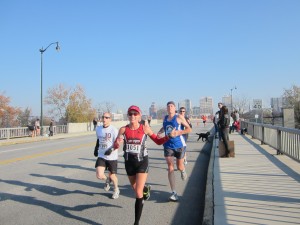 On my 5-year anniversary of my first race ever, I headed back to where it all started – the Philadelphia Broad Street Run. This 10-mile race was my first, and I have gone back every year. It’s silly to think that I have only been part of race culture for five short years. Those years have been packed with so many growing pains, knowledge, growth, and a love affair with road racing that won’t quit.
On my 5-year anniversary of my first race ever, I headed back to where it all started – the Philadelphia Broad Street Run. This 10-mile race was my first, and I have gone back every year. It’s silly to think that I have only been part of race culture for five short years. Those years have been packed with so many growing pains, knowledge, growth, and a love affair with road racing that won’t quit.
I remember how for years I ran, but never entered a race. I would run 20-30 mile weeks, simply to clear my head, sweat out stress, and feel good. I liked it. I don’t know how fast I’d run, and I have a rough idea on distance, but I was by no means the runner I am today. Like my journey, I am sure many of you have grown as athletes and human beings by leaps and bounds over the last five years. It’s really quite amazing to process that.
While my plan for this year’s Broad Street Run was to train my butt off and work to finally crack the 65 minute mark (my last two Broad Street Runs were 65:XX), this winter’s weather, being sick over and over, and my coaching load shut down that goal. I was slightly disappointed, as I love the opportunity to compete against myself. But pacing runners in races and long runs, and a terrible winter simply meant I had a winter filled with easy distance miles, not track repeats or tempo runs.
I decided the next best thing was to run the race with someone special. Luckily, I had a ton of special people running the race this year. Miracle of miracles, via lottery, my brother, friend and boyfriend all got spots. Since Alex and Chris (friend and boyfriend) were of similar pace and planned to run together, I decided I would run with my brother. At his first Broad Street Run in 2013, he ran about a 1:22 on barely any training.
I should mention here and now that while I love my brother, James, dearly; he is one of those people who always excels. He was the kid who wouldn’t study or would do his homework on the bus, and get straight A’s. Plus he was always cast as the lead in school plays, and a talented basketball player – and it all came easily to him. As his older sister who had to work for her good grades and extra curricular activities, I sometimes found this annoying. Now I find it amazing.
In true James fashion, he once again barely trained for the Broad Street Run. It’s not that he didn’t care or didn’t want to, but it wasn’t a priority. I told him we’d get him a PR of at least a sub-1:20. I knew that even if he were just in the shape he was last year, I could push him enough for that goal. And again, in true James fashion, he blew his current PR out of the water and ran a sub-1:12, on barely any training.
Race morning was cool, and it looked like rain. Still, we all agreed that cool and rainy was probably better than the 85 degree morning I had on that same course five years earlier. James and I said goodbye to Chris and Alex, and they walked to the green corral. James and I walked towards the starting line, and into the purple corral. It’s amazing to me that the race is now 40,000 runners. One of the things I love about Broad Street is that it truly is a Philadelphian’s race. Most of the runners live in Philly or the suburbs, and it’s often an event friends do together, tailgating for the Phillie’s game is a popular post-race choice. There are some runners who travel into town, but I’d say this race is as Philadelphia as you can get. I like it.
In the corral, James and I chatted as we tried to stay warm. I told him to not push the first mile, and to wait for the crowds to thin. Wasting time weaving around runners would add distance and expend energy, taking away from the benefit of a flat and fast course. Again, in true James fashion, this guy aced the notion of a negative split. Our first and slowest mile clocked a 7:34, and James told me he would be happy if we averaged 7:30s. Our miles slowly picked up pace as we went. As we passed the Temple University campus and the marching band, a spring in our step took us quickly towards City Hall. You can see City Hall from miles away. I told James that we’d pass City Hall after the 5-mile mark, so we should settle and not burn out until we hit the halfway mark. Our pace still continued to speed up, but because James didn’t look or sound like he was working very hard, I didn’t pull him back very much.
Around the 7-8 mile mark, James said his legs were beginning to tighten up. Did this slow his pace? Nope. At this point we were running 6:55-7:05 miles. I was simply in awe at how someone who has run maybe a dozen times since January could run 10 miles at this pace without feeling terrible, gasping for air, or getting injured. Who is this kid?!? Our last mile was our fastest, a 6:41. Ironically, I was winded at the end. My allergies made the last few miles hard on my breathing, and so when James took off at the end I was left to watch the tree tattoo on his back a few steps ahead of me. James had crushed his previous PR by over 10 minutes. On barely any training. Ridiculous.
At the finish, we grabbed refreshments and our medals, and waited for Chris and Alex at the family meeting area. James pointed out the many different gaits and running forms we saw on the course. I laughed, as I totally knew what he was talking about. The more you run, the more you notice things like running form.
I told James that I wondered what kind of time he could clock if he actually trained. I think he could whoop my butt and run 60-65 minutes – maybe faster. I am in awe. Again, knowing how hard I’ve had to work for certain race times, watching him pull off a time many runners out there that day didn’t have a prayer in achieving, probably while training – its amazing. As his big sister, I am super proud. As a coach, I would very much love the opportunity to coach him one year and see what would happen. However, in true James form, he’s probably too busy with other things (he does work a lot!) and will probably still go back and set a new PR in 2015.
As for me, I absolutely love pacing someone to a PR. Hopefully next year will be the year I go after that sub-65 minute finish. I know if I work hard, and weather cooperates on race day, its there. I know it is. I just need to make it happen.









